元音字母开音节和闭音节中的读音
- 格式:doc
- 大小:169.00 KB
- 文档页数:10

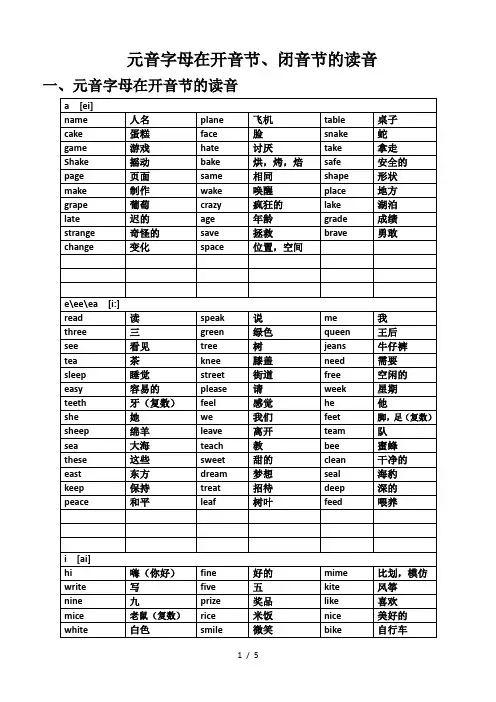

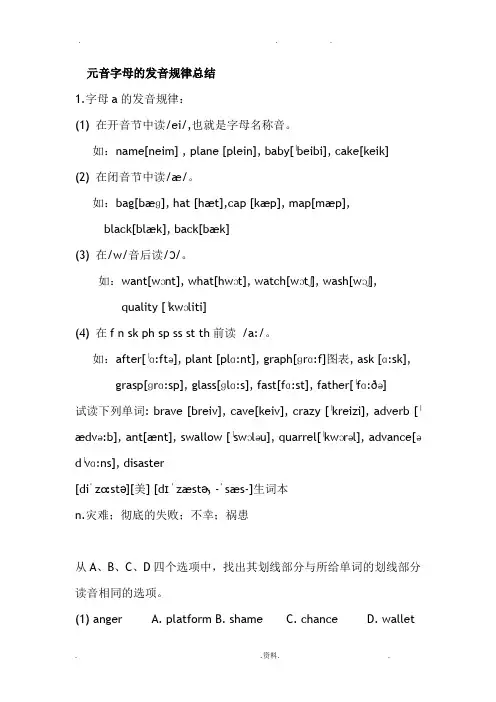
元音字母的发音规律总结1.字母a的发音规律:(1) 在开音节中读/ei/,也就是字母名称音。
如:name[neim] , plane [plein], baby[ˈbeibi], cake[keik] (2) 在闭音节中读/æ/。
如:bag[bæɡ], hat [hæt],cap [kæp], map[mæp],black[blæk], back[bæk](3) 在/w/音后读/Ɔ/。
如:want[wɔnt], what[hwɔt], watch[wɔtʃ], wash[wɔʃ],quality [ˈkwɔliti](4) 在f n sk ph sp ss st th前读/a:/。
如:after[ˈɑ:ftə], plant [plɑ:nt], graph[ɡrɑ:f]图表, ask [ɑ:sk], grasp[ɡrɑ:sp], glass[ɡlɑ:s], fast[fɑ:st], father[ˈfɑ:ðə]试读下列单词: brave [breiv], cave[keiv], crazy [ˈkreizi], adverb [ˈædvə:b], ant[ænt], swallow [ˈswɔləu], quarrel[ˈkwɔrəl], advance[ədˈvɑ:ns], disaster[diˈzɑ:stə][美] [dɪˈzæstɚ, -ˈsæs-]生词本n.灾难;彻底的失败;不幸;祸患从A、B、C、D四个选项中,找出其划线部分与所给单词的划线部分读音相同的选项。
(1) anger A. platform B. shame C. chance D. wallet(2) rather A. practice B. thankful C. Congratulation D. T ask2. 字母e的发音规律:(1) 在开音节中读/i:/。
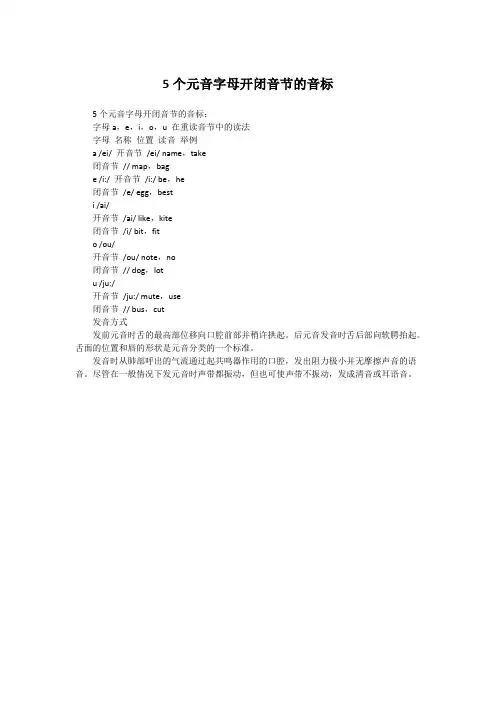
5个元音字母开闭音节的音标
5个元音字母开闭音节的音标:
字母a,e,i,o,u 在重读音节中的读法
字母名称位置读音举例
a /ei/ 开音节/ei/ name,take
闭音节// map,bag
e /i:/ 开音节/i:/ be,he
闭音节/e/ egg,best
i /ai/
开音节/ai/ like,kite
闭音节/i/ bit,fit
o /ou/
开音节/ou/ note,no
闭音节// dog,lot
u /ju:/
开音节/ju:/ mute,use
闭音节// bus,cut
发音方式
发前元音时舌的最高部位移向口腔前部并稍许拱起。
后元音发音时舌后部向软腭抬起。
舌面的位置和唇的形状是元音分类的一个标准。
发音时从肺部呼出的气流通过起共鸣器作用的口腔,发出阻力极小并无摩擦声音的语音。
尽管在一般情况下发元音时声带都振动,但也可使声带不振动,发成清音或耳语音。


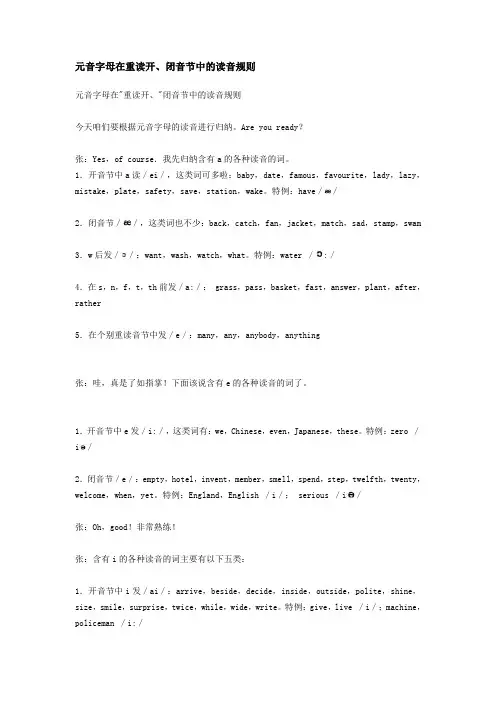
元音字母在重读开、闭音节中的读音规则元音字母在"重读开、"闭音节中的读音规则今天咱们要根据元音字母的读音进行归纳。
Are you ready?张:Yes,of course.我先归纳含有a的各种读音的词。
1.开音节中a读/ei/,这类词可多啦:baby,date,famous,favourite,lady,lazy,mistake,plate,safety,save,station,wake。
特例:have//2.闭音节//,这类词也不少:back,catch,fan,jacket,match,sad,stamp,swam3.w后发//:want,wash,watch,what。
特例:water /:/4.在s,n,f,t,th前发/a:/: grass,pass,basket,fast,answer,plant,after,rather5.在个别重读音节中发/e/:many,any,anybody,anything张:哇,真是了如指掌!下面该说含有e的各种读音的词了。
1.开音节中e发/i:/,这类词有:we,Chinese,even,Japanese,these。
特例:zero /i/2.闭音节/e/:empty,hotel,invent,member,smell,spend,step,twelfth,twenty,welcome,when,yet。
特例:England,English /i/; serious /i/张:Oh,good!非常熟练!张:含有i的各种读音的词主要有以下五类:1.开音节中i发/ai/:arrive,beside,decide,inside,outside,polite,shine,size,smile,surprise,twice,while,wide,write。
特例:give,live /i/;machine,policeman /i:/2.闭音节中发/i/:bring,history,lift,list,picnic,quick,spring,stick,still,thin,ticket,till,winter,wish。
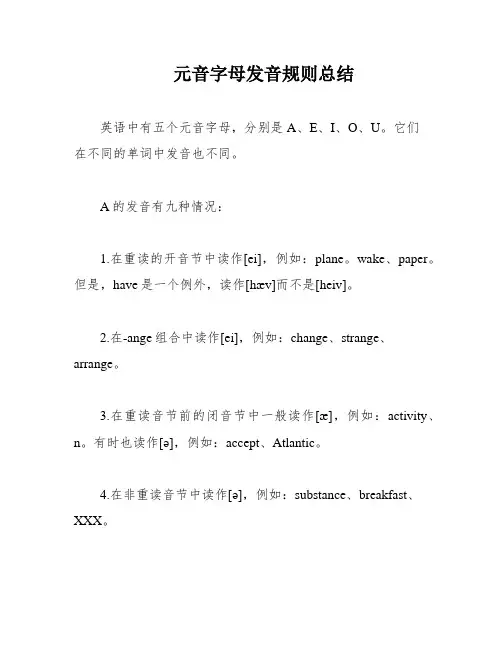
元音字母发音规则总结英语中有五个元音字母,分别是A、E、I、O、U。
它们在不同的单词中发音也不同。
A的发音有九种情况:1.在重读的开音节中读作[ei],例如:plane。
wake、paper。
但是,have是一个例外,读作[hæv]而不是[heiv]。
2.在-ange组合中读作[ei],例如:change、strange、arrange。
3.在重读音节前的闭音节中一般读作[æ],例如:activity、n。
有时也读作[ə],例如:accept、Atlantic。
4.在非重读音节中读作[ə],例如:substance、breakfast、XXX。
5.在“a+辅音字母(除r、w之外)+不发音的e”的非重读音节中一般读作[i],例如:comrade、courage。
但是,“-ate”中的a不论重读还是非重读都读作[ei],例如:calculate、late、hesitate。
这里有两个例外,一个是separate的形容词形式,读作[’sepərit],另一个是climate,读作[’klaimit]。
6.在w、wh后面读作[ɔ],例如:what、XXX是例外,这个单词按照重读开音节读作[weil]。
7.在W后面读作[ɔ:],例如:water、watch、XXX和wake是例外,要按照重读开音节分别读作[weiv]和[weik]。
8.在l前面读作[ɔ:],例如:chalk、XXX、always、XXX。
但是,shall、XXX、shallow中读作[æ],wallet读作[’wɔlit]。
这些规则可以帮助我们正确地发音。
A 发 [a:] 的情况有以下几种:1.在 s 之前,例如class [ [ [ [’ haste [heist] 和 taste [teist],而 passage 按照重读闭音节规则读音,读做[’pæsidʒ]。
2.在“m/n + 辅音字母” 之前,例如 advance [əd’ [ [ [grænd] 是例外。
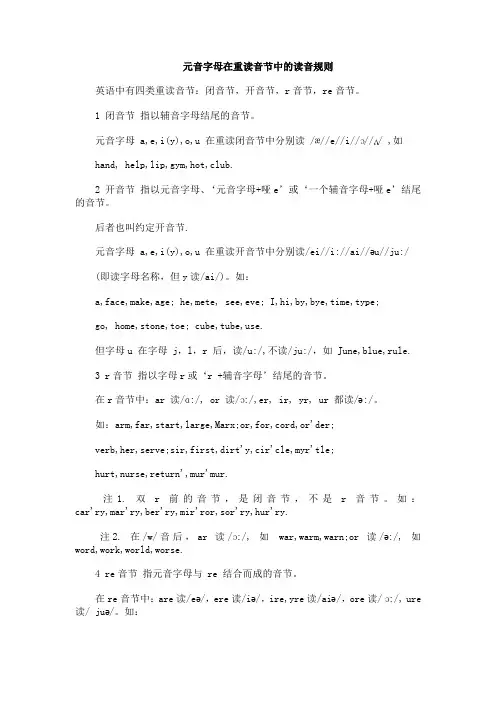
元音字母在重读音节中的读音规则英语中有四类重读音节:闭音节,开音节,r音节,re音节。
1 闭音节指以辅音字母结尾的音节。
元音字母 a,e,i(y),o,u 在重读闭音节中分别读/æ//e//i//ɔ//ʌ/ ,如hand, help,lip,gym,hot,club.2 开音节指以元音字母、‘元音字母+哑e’或‘一个辅音字母+哑e’结尾的音节。
后者也叫约定开音节.元音字母 a,e,i(y),o,u 在重读开音节中分别读/ei//i://ai//ǝu//ju:/(即读字母名称,但y读/ai/)。
如:a,face,make,age; he,mete, see,eve; I,hi,by,bye,time,type;go, home,stone,toe; cube,tube,use.但字母u 在字母 j,l,r 后,读/u:/,不读/ju:/,如 June,blue,rule.3 r音节指以字母r或‘r +辅音字母’结尾的音节。
在r音节中:ar 读/ɑ:/, or 读/ɔ:/,er, ir, yr, ur 都读/ǝ:/。
如:arm,far,start,large,Marx;or,for,cord,or'der;verb,her,serve;sir,first,dirt'y,cir'cle,myr'tle;hurt,nurse,return',mur'mur.注1. 双r前的音节,是闭音节,不是r音节。
如:car'ry,mar'ry,ber'ry,mir'ror,sor'ry,hur'ry.注2. 在/w/音后,ar读/ɔ:/, 如war,warm,warn;or读/ǝ:/, 如word,work,world,worse.4 re音节指元音字母与 re 结合而成的音节。
在re音节中:are读/eǝ/,ere读/iǝ/,ire,yre读/aiǝ/,ore读/ ɔ:/, ure 读/ juǝ/。
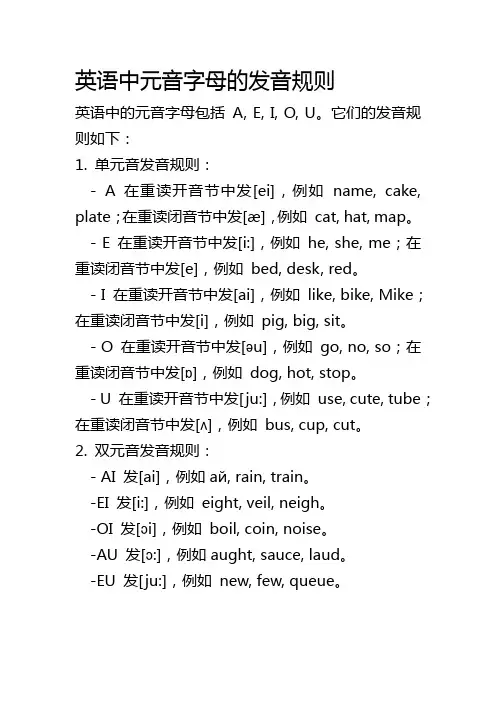
英语中元音字母的发音规则
英语中的元音字母包括A, E, I, O, U。
它们的发音规则如下:
1. 单元音发音规则:
- A 在重读开音节中发[ei],例如name, cake, plate;在重读闭音节中发[æ],例如cat, hat, map。
- E 在重读开音节中发[i:],例如he, she, me;在重读闭音节中发[e],例如bed, desk, red。
- I 在重读开音节中发[ai],例如like, bike, Mike;在重读闭音节中发[i],例如pig, big, sit。
- O 在重读开音节中发[əu],例如go, no, so;在重读闭音节中发[ɒ],例如dog, hot, stop。
- U 在重读开音节中发[ju:],例如use, cute, tube;在重读闭音节中发[ʌ],例如bus, cup, cut。
2. 双元音发音规则:
- AI 发[ai],例如ай, rain, train。
-EI 发[i:],例如eight, veil, neigh。
-OI 发[ɔi],例如boil, coin, noise。
-AU 发[ɔ:],例如aught, sauce, laud。
-EU 发[ju:],例如new, few, queue。
需要注意的是,元音字母的发音会受到前后音节和重音位置的影响,同一个元音字母在不同的单词中可能会有不同的发音。
什么是开音节、闭音节,a.e.i.o.u在开音节、闭音节中的读法.我爱这土地发表于2006-6-2 21:41:35什么是开音节、闭音节,a.e.i.o.u在开音节、闭音节中的读法.答:开音节就是元音字母后面没有辅音字母为绝对开音节,元音字母+辅音字母(r除外)+不发音字母e/时,为相对开音节,如:绝对开音节no [n[u],相对开音节note[n[ut]闭音节就是元音字母后有辅音字母,如:not[not] left"> 字母a在重读开音节中读作[ei],在重读闭音节中一般读作[A],a+ss, st, sp, sk, th, f,n时常读[a:],在-r音节中读作[a:],在-re音节中读作[Z[]等。
字母e在重读音节中读音规则,在开音节中读作[i:],如he[hi:], these[TI:z],在闭音节中读[e],如:bed[bed],在-r音节中读[[:],如her[h[:],在re音节中读[i[]或[Z[],如:here[hi[],there[TZ[]。
字母i在重读音节中读音规则:在开音节中读作[ai],如hi[hai],like[laik],在闭音中读作[i],如it [it]. 字母o读音规则,在开音节中读作[[u],no[n[u] , note[n[ut],在闭音节中读作[C],not[nCt].字母u读音规则,在开音节中读作[ju:], use [ju:s],在l, r, j+u时读作[u:], rule[ru:l],在p后常读作[u],put[put].一、音节:音节是读音的基本单位,任何单词的读音,都是分解为一个个音节朗读。
在英语中元音特别响亮,一个元音可构成一个音节,一个元音和一个或几个辅音音素结合也可以构成一个音节。
一般说来,元音可以构成音节,辅音不响亮,不能构成音节。
但英语辅音字母中有4 个辅音[m],[n],[ng],[l]是响音,它们和辅音音素结合,也可构成音节。
元音字母开音节和闭音节中的读音编辑a•①在开音节中/eɪ/n a me,pl a ne,J a ne,b a by,c a ke•②在闭音节中/æ/b a g,d a d,h a t,m a p,bl a ck,b a cke•①在开音节中/i:/h e,th e se,m e,Chin e se•②在闭音节中/e/b e d,l e t,p e n,d e sk,y e s,e ggi•①在开音节中/aɪ/b i ke,dr i ve,t i me,n i ce,k i te•②在闭音节中/ɪ/f i sh,b i g,dr i nk,s i t,m i lk,sw i mo•①在开音节中/əʊ/th o se,cl o se,g o,h o e,h o me,n o•②在闭音节中/ɒ/cl o ck,n o t,b o x,sh o p,s o cku•①在开音节中i./ju:/st u dent,exc u se,d u ty,T u esdayii.元音字母u在辅音字母j,l,r,s后面时读/u:/音,例如:J u ne,bl u e,r u ler,s u per。
•②在闭音节中/ʌ/b u s,c u p,j u mp,m u ch,l u nch元音字母在重读音节中的特殊读音编辑a•①在/w/音后面/ɒ/w a nt,wh a t,w a tch,w a sh,qu a lity•②在f,n,sk,ph,sp,ss,st,th前/α:/a fter,pl a nt,a sk,gr a sp,gl a ss,f a st,f a ther i•在-nd,-ld和gh前/aɪ/f i nd,ch i ld,l i ght,h i gho•①在-st,-ld前/əʊ/m o st,p o stcard,o ld,c o ld•②在m,n,v,th前/ʌ/c o me,m o nkey,l o ve,m o ther元音字母在非重读音节中的读音编辑a•/ə/Chin a,a nother,wom a n,breakf a st•动词中的a如果处在开音节位置,a读/eɪ/音,例如:oper a te,a处在开音节位置e•/ə/hundr e d,stud e nt,op e n,week e nd,chick e n,childr e ni•①/ɪ/hol i day,beaut i ful,fam i ly,an i mal•②/aɪ/exerc i se,satell i teo•①/ə/sec o nd,t o night,someb o dy,welc o me•②/əʊ/als o,zer o,phot ou•①/ə/aut u mn,diffic u lt•②/ju:/pop u lar,congrat u lation,Jan u ary•③在辅音字母j,l,r,s后面时,读/ʊ/或/u:/音,例如:J u ly,infl u ence,Febr u ary,iss u e。
元音字母开音节和闭音节中的读音编辑a•①在开音节中/eɪ/n a me,pl a ne,J a ne,b a by,c a ke•②在闭音节中/æ/b a g,d a d,h a t,m a p,bl a ck,b a cke•①在开音节中/i:/h e,th e se,m e,Chin e se•②在闭音节中/e/b e d,l e t,p e n,d e sk,y e s,e ggi•①在开音节中/aɪ/b i ke,dr i ve,t i me,n i ce,k i te•②在闭音节中/ɪ/f i sh,b i g,dr i nk,s i t,m i lk,sw i mo•①在开音节中/əʊ/th o se,cl o se,g o,h o e,h o me,n o•②在闭音节中/ɒ/cl o ck,n o t,b o x,sh o p,s o cku•①在开音节中i./ju:/st u dent,exc u se,d u ty,T u esdayii.元音字母u在辅音字母j,l,r,s后面时读/u:/音,例如:J u ne,bl u e,r u ler,s u per。
•②在闭音节中/ʌ/b u s,c u p,j u mp,m u ch,l u nch元音字母在重读音节中的特殊读音编辑a•①在/w/音后面/ɒ/w a nt,wh a t,w a tch,w a sh,qu a lity•②在f,n,sk,ph,sp,ss,st,th前/α:/a fter,pl a nt,a sk,gr a sp,gl a ss,f a st,f a ther i•在-nd,-ld和gh前/aɪ/f i nd,ch i ld,l i ght,h i gho•①在-st,-ld前/əʊ/m o st,p o stcard,o ld,c o ld•②在m,n,v,th前/ʌ/c o me,m o nkey,l o ve,m o ther元音字母在非重读音节中的读音编辑a•/ə/Chin a,a nother,wom a n,breakf a st•动词中的a如果处在开音节位置,a读/eɪ/音,例如:oper a te,a处在开音节位置e•/ə/hundr e d,stud e nt,op e n,week e nd,chick e n,childr e ni•①/ɪ/hol i day,beaut i ful,fam i ly,an i mal•②/aɪ/exerc i se,satell i teo•①/ə/sec o nd,t o night,someb o dy,welc o me•②/əʊ/als o,zer o,phot ou•①/ə/aut u mn,diffic u lt•②/ju:/pop u lar,congrat u lation,Jan u ary•③在辅音字母j,l,r,s后面时,读/ʊ/或/u:/音,例如:J u ly,infl u ence,Febr u ary,iss u e。
•在非重读音节中,许多单词中的元音字母a,e,i既可以读/ə/的音,也可以读/ɪ/的音。
-r音节元音字组在重读音节中的读音编辑ar•①/α:/c ar,f ar m,d ar k,sh ar pener•②在/w/音后面/ɔ:/w ar m,qu ar ter,tow ar dsor•①/ɔ:/f or ty m or ning sh or t•②/ɜ:/w or d w or ker w or seer,ir,ur•/ɜ:/c er tainly b ir d Th ur sday•注:①辅音字母r双写时,前面的元音字母不能与r构成-r音节,而是按重读闭音节的拼读规则发音。
例如:carry,sorry,hurry。
②-r音节在非重读音节常读/ə/音,例如:doll ar,teach er,mart yr,f or get,Sat ur day。
-re音节元音字组在重读音节中的读音编辑are•/eə/c are,d are,h areere•/ɪə/h ere,m ereire•/aɪə/f ire,h ire,w ireore•/ɔ:/m ore,sc ore,bef oreure•/jʊə/p ure,c ure-re•/ə/cent re,fib re,tit re,meag re,saltpet re注•①are,ere,ire,ore很少出现在非重读音节中,ure在非重读音节中读/ə/音,例如:pict ure,pleas ure。
•②重读元音字母加r,再加非重读元字组时,重读元音字母应按-re音节拼读规则拼读,字母r读/r/音。
例如:parent,zero,story,during,inspiring。
•③另外,某些常用词及多音节词经常出现长音短化现象。
例如:o range,v e ry,Am e rican,p a ragraph。
元音字组在重读音节中的读音编辑ai,ay•/eɪ/afr ai d,r ai n,w ai t,d ay,pl ayair•/eə/air,h air,ch air,p air,rep airal•①在l,k前/ɔ:/sm al l,b al l,t al k,w al l,al l,t al k,•②/ɔ:l/al ways,al so,s al t,al most•③在f,m前/α:/h al f,c al mau,aw•/ɔ:/au tumn,d au ghter,dr awea•①/i:/t ea ch,ea sy,ch ea p,pl ea se•②/e/h ea vy,br ea d,sw ea ter,w ea ther•③/eɪ/br ea k,gr ea tear•①/ɪə/h ear,d ear,n ear,cl ear,y ear•②/eə/b ear,p ear,w ear,sw ear•③/ɜ:/ear th,l ear n,ear lyee•/i:/j ee p,w ee k,gr ee n,thr eeeer•/ɪə/pion eer,d eer,b eerei,ey•①/eɪ/ei ght,n ei ghbour,th ey•②/i:/s ei ze,k eyeu,ew•①在j,l,r,s后/ju:/n ew,f ew,n ew spaper•②/u:/fl ew,br ew,j ew elryie,ei•/s/音之后/i:/p ie ce,f ie ld,rec ei veoa•/əʊ/c oa t,J oa n,b oa t,g oa loar,oor•/ɔ:/r oar,b oar d,d oor,fl ooroi,oy•/ɔɪ/n oi se,p oi nt,b oy,t oi letoo•/u:/br oo m,f oo d,t oo th,sch oo l,z oo•/ʊ/b oo k,l oo k,c oo k,f oo t,g oo d, f oo tballou,ow•①/aʊ/fl ow er,h ou se,c ou nt,d ow n•②/əʊ/kn ow,r ow,thr ow,th ou gh•③/ʌ/y ou ng,c ou ntry,en ou gh•④/u:/gr ou p,s ou pour•①/ɔ:/ c our se,y our,f our•②/aʊə/our,h our,s our•③/ɜ:/j our neyoul•/ʊ/w oul d,sh oul d,c oul d(主要是情态动词、助动词)ui•①在j,l,r,s后/ju:ɪ/fl ui d,s ui cide,t ui tion•②/u:/j ui ce,fr ui t,s ui t非重读音节中元音字组和字群的读音编辑ai,ay,ei,ey•/ɪ/for ei gn,monk eyow•/əʊ/yell ow,sparr ow,tomorr ow•注:元音字组在非重读音节常读/ə/音或/ɪ/音。
例如:seri ou s,fam ou s,bisc ui t,coff ee,neighb our-sion,-tion•①/ʃən/impres sion,na tion•②在元音字母后/ʒən/vi sion,deci sion,occa sion•③在s后/tʃən/ques tion,sugges tion-isle•/aɪl/a isle, Carl isle-sten•/sən/li sten-stle•/sl/whi stle-sure•/ʒə/plea sure,mea sure-ture•/tʃə/pict ure,cult ure元字组在复合词非重读音节中的读音编辑•复合词中的第二部分不标注重音符号,但其中的元音字母或元音字组仍按重读音节拼读规则拼读。
例如:everyd ay/eɪ/,h a ndb a g/æ/,blackb oar d/ɔ:/。
有些词随着语言的发展,前后两部分已失去其单独存在的意义,融合成为一个词。
其中的非重读部分要按非重读音节的读音规则发音。
例如:holy(神圣)+d ay/eɪ/(日子)=holid ay/ɪ/(假日):br ea k(中断)+f a st/α:/(斋戒)=br ea kf a st/ə/(早餐);cup(茶杯)+b oar d/ɔ:/(木板)=cupb oar d/ə/(碗柜)。
辅字组的读音编辑b•①/b/b ike,b us,b ag•②/不发/bom b,tom bc•①在e前或在i,y前/s/fa c e,de c ide,c inema•②其他情况/k/c ake,pi c ture,c oat,musi c•③/tʃ/c elloch•①/tʃ/mu ch,ch ick,ri ch,tea ch er•②/k/s ch ool,heada ch e,ch emistry(主要为希腊外来词)•③/ʃ/ma ch ine,mousta ch e(主要是法语外来词)-ck[k]co ck,po ck et,bla ck,kno ckcz•[tʃ]Cz echd•/d/d octor,brea d,han d,d ay-dg(e)•/dʒ/bri dg e,fri dg edr-•/dr/chil dr en,dr iver,dr inkds•/dz/han ds(主要用于可数名词复数)f•/f/f ive,f our,break f ast•/v/o fg•①/g/ba g,g arden,g o•②/dʒ/oran g e,lar g e,G erman•③/ʒ/g enre,massa g egh•①/f/cou gh,enou gh•②/不发/li gh t,dau gh ter,hi ghgu-,-gue•①/g/gu ess,lea gue,dialo gue(-gue在非重读音节中)•②/gw/lan gu age,an gu ishh•①/h/h ot,h ead,h ouse,h and•②/不发/h our,h onestj•①/dʒ/j eep,jar,j oke,j oin,J une•②/ʒ/J acques(用于法国人名)•③/h/J uanita(用于西班牙人名)k•/k/k ind,bi k e,s k ate,ma k e,wee kkn-•/n/kn ife,kn ow,kn ockl•①/l/l ife,l ead,l ot(出现在元音前面)•②/ɫ/mi l k,schoo l,tal l[出现在元音后面。